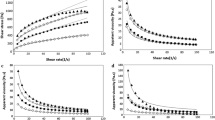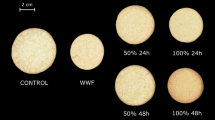Abstract
Apple pomace (AP) is a by-product of the juice industry, rich in dietary fiber (45.06%), which is generated in large quantities. The objectives of the present work were to evaluate the effect of the particle size and the level of replacement with AP on the quality of sugar-snap cookies. Dehydrated AP was ground to three different particle sizes (d(4,3) = 362, 482, 840 μm) to substitute 15% and 30% of wheat flour in cookie formulations. The quality of dough and cookies was evaluated in terms of rheological properties, color, texture, and global acceptability of the final product. When the AP particle size decreased, the water absorption properties (WHC, WBC) were higher (33 and 10% respectively for the lowest and the highest particle size). For both replacement levels, the smallest particle size (362 μm) led to the highest dynamic moduli of dough. The spread ratio (SR) of the cookies diminished when the particle size decreased (from 6.4 to 4.8 corresponding to AP840 and AP362 respectively). The lowest SRs were obtained for the 30% replacement level except for AP362. When employing AP with the largest particle size (840 μm), the cookies were less hard (48.7 N). The addition of AP to sugar-snap cookies led to higher global acceptability scores than for control cookies. The sensory attribute that most differentiated the cookies with AP was their pleasant taste being the taste score always higher than the control one.





Similar content being viewed by others
References
AACC International. (2012). Approved methods of the American Association of Cereal Chemists International. Methods: 44e15.02 (moisture), 56-30.01 (WBC), 88-04 (WHC) (11th ed.). St Paul: American Association of Cereal Chemists.
ADA. (2002). Position of the American Dietetic Association: health implications of dietary fiber. ADA Reports, 102(7), 993–1000.
Ahmed, J., Al-Attar, H., & Arfat, Y. A. (2016). Effect of particle size on compositional, functional, pasting and rheological properties of commercial water chestnut flour. Food Hydrocolloids, 52, 888–895.
AOAC. (1990). Official methods of analysis. In Association of Analytical Chemists. Washington, DC: AOAC.
Bhushan, S., Kalia, K., Sharma, M., Singh, B., & Ahuja, P. S. (2008). Processing of apple pomace for bioactive molecules. Critical Reviews in Biotechnology, 28(4), 285–296.
Caparino, O. A., Tang, J., Nindo, C. I., Sablani, S. S., Powers, J. R., & Fellman, J. K. (2012). Effect of drying methods on the physical properties and microstructures of mango (Philippine “Carabao” var.) powder. Journal of Food Engineering, 111(1), 135–148.
Chau, C. F., Wang, Y. T., & Wen, Y. L. (2007). Different micronization methods significantly improve the functionality of carrot insoluble fibre. Food Chemistry, 100(4), 1402–1408.
Dayakar Rao, B., Anis, M., Kalpana, K., Sunooj, K. V., Patil, J. V., & Ganesh, T. (2016). Influence of milling methods and particle size on hydration properties of sorghum flour and quality of sorghum biscuits. LWT - Food Science and Technology, 67, 8–13.
De La Hera, E., Martinez, M., & Gómez, M. (2013). Influence of flour particle size on quality of gluten-free rice bread. LWT - Food Science and Technology, 54(1), 199–206.
Dhillon, G. S., Kaur, S., Brar, S. K., & Verma, M. (2012). Potential of apple pomace as a solid substrate for fungal cellulase and hemicellulase bioproduction through solid-state fermentation. Industrial Crops and Products, 38(1), 6–13.
Elleuch, M., Bedigian, D., Roiseux, O., Besbes, S., Blecker, C., & Attia, H. (2011). Dietary fibre and fibre-rich by-products of food processing: Characterisation, technological functionality and commercial applications: a review. Food Chemistry, 124(2), 411–421.
Gómez, M., & Martinez, M. M. (2017). Fruit and vegetable by-products as novel ingredients to improve the nutritional quality of baked goods. Critical Reviews in Food Science and Nutrition, 0(0), 1–17.
Grover, S. S., Chauhan, G. S., & Masoodi, F. A. (2003). Effect of particle size on surface properties of apple pomace. International Journal of Food Properties, 6(1), 1–7.
Guillon, F., & Champ, M. (2000). Structural and physical properties of dietary fibres, and consequences of processing on human physiology. Food Research International, 33(3–4), 233–245.
Jung, J., Cavender, G., & Zhao, Y. (2015). Impingement drying for preparing dried apple pomace flour and its fortification in bakery and meat products. Journal of Food Science and Technology, 52(9), 5568–5578.
Kohajdová, Z., Karovičová, J., Magala, M., & Kuchtová, V. (2014). Effect of apple pomace powder addition on farinographic properties of wheat dough and biscuits quality. Chemical Papers, 68(8), 1059–1065.
Laguna, L., Sanz, T., Sahi, S., & Fiszman, S. M. (2014). Role of fibre morphology in some quality features of fibre-enriched biscuits. International Journal of Food Properties, 17(1), 163–178.
Lavelli, V., & Kerr, W. (2012). Apple pomace is a good matrix for phytochemical retention. Journal of Agricultural and Food Chemistry, 60(22), 5660–5666.
Leyva-Corral, J., Quintero-Ramos, A., Camacho-Dávila, A., de Jesús Zazueta-Morales, J., Aguilar-Palazuelos, E., Ruiz-Gutiérrez, M. G., Meléndez-Pizarro, C. O., & de Jesús Ruiz-Anchondo, T. (2016). Polyphenolic compound stability and antioxidant capacity of apple pomace in an extruded cereal. LWT - Food Science and Technology, 65, 228–236.
Lin, M. J., Humbert, E. S., & SosuIski, F. W. (1974). Certain functional properties of sunflower meal products. Journal of Food Science, 39(2), 368–370.
Lin, C., Pfaltzgraff, L. A., Herrero-Davila, L., Mubofu, E. B., Solhy, A., Clark, J., et al. (2013). Food waste as a valuable resource for the production of chemicals, materials and fuels. Current situation and global perspective. Energy & Environmental Science, 6(2), 426–464.
Liu, J. C., Jiao, Z. G., Liang, X. H., Han, L., & Liu, H. (2011). Effect of ultrafine pulverization on properties of apple pomace powder. Advanced Materials Research, 236–238, 2560–2563.
Mancebo, C. M., Picón, J., & Gómez, M. (2015). Effect of flour properties on the quality characteristics of gluten free sugar-snap cookies. LWT - Food Science and Technology, 64(1), 264–269.
Mancebo, C. M., Rodríguez, P., Martínez, M. M., & Gómez, M. (2018). Effect of the addition of soluble (nutriose, inulin and polydextrose) and insoluble (bamboo, potato and pea) fibres on the quality of sugar-snap cookies. International Journal of Food Science and Technology, 53(1), 129–136.
Mieszkowska, A., & Marzec, A. (2016). Effect of polydextrose and inulin on texture and consumer preference of short-dough biscuits with chickpea flour. LWT - Food Science and Technology, 73, 60–66.
Moreira, R., Chenlo, F., Torres, M. D., & Prieto, D. M. (2010). Influence of the particle size on the rheological behaviour of chestnut flour doughs. Journal of Food Engineering, 100(2), 270–277.
Naknaen, P., Itthisoponkul, T., Sondee, A., & Angsombat, N. (2016). Utilization of watermelon rind waste as a potential source of dietary fiber to improve health promoting properties and reduce glycemic index for cookie making. Food Science and Biotechnology, 25(2), 415–424.
Nawirska, A., & Kwaśniewska, M. (2005). Dietary fibre fractions from fruit and vegetable processing waste. Food Chemistry, 91(2), 221–225.
O’shea, N., Arendt, E. K., & Gallagher, E. (2012). Dietary fibre and phytochemical characteristics of fruit and vegetable by-products and their recent applications as novel ingredients in food products. Journal of Agricultural Science and Technology, 16, 1–10.
Pareyt, B., & Delcour, J. A. (2008). The role of wheat flour constituents, sugar, and fat in low moisture cereal based products: A review on sugar-snap cookies. Critical Reviews in Food Science and Nutrition, 48(9), 824–839.
Petrović, J., Fišteš, A., Rakić, D., Pajin, B., Lončarević, I., & Šubarić, D. (2015). Effect of defatted wheat germ content and its particle size on the rheological and textural properties of the cookie dough. Journal of Texture Studies, 46(5), 374–384.
Quiles, A., Campbell, G. M., Struck, S., Rohm, H., & Hernando, I. (2016). Fiber from fruit pomace: a review of applications in cereal-based products. Food Reviews International, 9129(November), 1–20.
Robertson, J. A., & Eastwood, M. A. (1981). An examination of factors which may affect the water holding capacity of dietary fibre. British Journal of Nutrition, 45(1), 83–88.
Rocha Parra, A. F., Ribotta, P. D., & Ferrero, C. (2015a). Apple pomace in gluten-free formulations: effect on rheology and product quality. International Journal of Food Science & Technology, 50(3), 682–690.
Rocha Parra, A. F., Ribotta, P. D., & Ferrero, C. (2015b). Starch-apple pomace mixtures: pasting properties and microstructure. Food and Bioprocess Technology, 8(9), 1854–1863.
Rosell, C. M., Santos, E., & Collar, C. (2009). Physico-chemical properties of commercial fibres from different sources: a comparative approach. Food Research International, 42(1), 176–184.
Schieber, A., Stintzing, F. C., & Carle, R. (2001). By-products of plant food processing as a source of functional compounds - recent developments. Trends in Food Science and Technology, 12(11), 401–413.
Singh, A., Rana, I., Sahi, N. C., Lohani, U. C., & Chand, K. (2012). Optimization of process variables for preparation of apple pomace - black soyflour based biscuits. International Journal of Food, Agriculture and Veterinary Sciences, 2(1), 101–106.
Sozer, N., Cicerelli, L., Heiniö, R.-L., & Poutanen, K. (2014). Effect of wheat bran addition on in vitro starch digestibility, physico-mechanical and sensory properties of biscuits. Journal of Cereal Science, 60(1), 105–113.
Sudha, M. L., Baskaran, V., & Leelavathi, K. (2007). Apple pomace as a source of dietary fiber and polyphenols and its effect on the rheological characteristics and cake making. Food Chemistry, 104(2), 686–692.
Sudha, M. L., Dharmesh, S. M., Pynam, H., Bhimangouder, S. V., Eipson, S. W., Somasundaram, R., & Nanjarajurs, S. M. (2016). Antioxidant and cyto/DNA protective properties of apple pomace enriched bakery products. Journal of Food Science and Technology, 53(4), 1909–1918.
Toledo, N. M. V., Nunes, L. P., da Silva, P. P. M., Spoto, M. H. F., & Canniatti-Brazaca, S. G. (2017). Influence of pineapple, apple and melon by-products on cookies: physicochemical and sensory aspects. International Journal of Food Science and Technology, 52(5), 1185–1192.
World Health Organization. (2003). Diet, nutrition and the prevention of chronic diseases. Technical report series # 916. 1. Chapter 5. Geneva: World Health Organization.
Zucco, F., Borsuk, Y., & Arntfield, S. D. (2011). Physical and nutritional evaluation of wheat cookies supplemented with pulse flours of different particle sizes. LWT - Food Science and Technology, 44(10), 2070–2076.
Acknowledgments
The authors want to acknowledge the apple pomace donation by Jugos SA of Rio Negro, Argentina.
Funding
This study is financially supported by the Spanish Ministry of Economy and Competitiveness (Project AGL2014-52928-C2-2-R) and the European Regional Development Fund (FEDER) and the University of La Plata (Projects 11/X661 and 11/X771) and CONICET from Argentina.
Author information
Authors and Affiliations
Corresponding author
Additional information
Publisher’s Note
Springer Nature remains neutral with regard to jurisdictional claims in published maps and institutional affiliations.
Rights and permissions
About this article
Cite this article
Rocha Parra, A.F., Sahagún, M., Ribotta, P.D. et al. Particle Size and Hydration Properties of Dried Apple Pomace: Effect on Dough Viscoelasticity and Quality of Sugar-Snap Cookies. Food Bioprocess Technol 12, 1083–1092 (2019). https://doi.org/10.1007/s11947-019-02273-3
Received:
Accepted:
Published:
Issue Date:
DOI: https://doi.org/10.1007/s11947-019-02273-3




